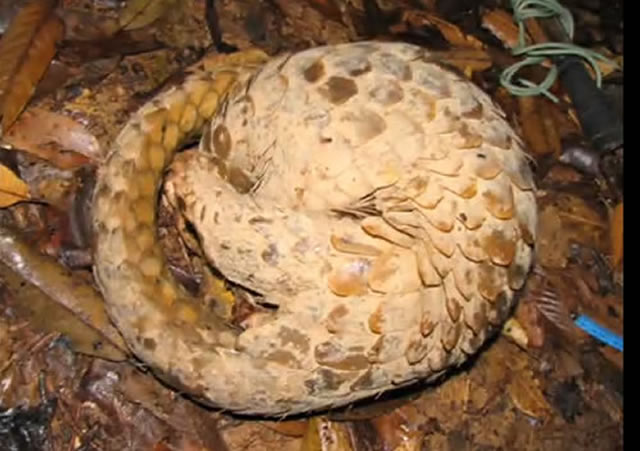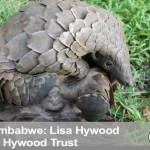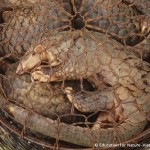Meet ‘MJ6’ – a VIP (Very Important Pangolin)!

One of the biggest challenges in pangolin conservation is that we know very little about these secretive, elusive creatures.
Our knowledge and understanding of them seems to center on the fact that poaching and habitat loss have placed them on the brink of extinction and now threatens to send them beyond the point of no return.
While most research has focused on the endangered Chinese pangolin and Africa’s tree pangolin, most of what is known about the Sunda pangolin — also endangered and currently one of the most heavily targeted mammals in the world for illegal wildlife trade — is anecdotal.
To date, no detailed studies regarding population sizes for this species have been published and only a single field study has focused on its ecology and life history.
Although the study followed just one adult female, and had its fair share of obstacles, the research has contributed greatly to our knowledge of the Sunda pangolin (Manis javanica).
However, more work is desperately needed if we are to save the scaly anteaters.
This article explores the findings of the study, as published in Endangered Species Research‘s “Home range, activity cycle and natal den usage of a female Sunda pangolin Manis javanica (Mammalia: Pholidota) in Singapore”, by Norman Lim and Peter Ng.
Watch a video of the elusive Sunda pangolin:
The site
The first and only detailed study of the Sunda pangolin in its natural habitat took place in 2005 on an island called Palau Tekong, located off the northeast shore of Singapore.
The island is primarily used for military training and experiences relatively low human impacts on its ecosystems, which include mangroves, herbaceous vegetation, and deciduous, secondary growth forests.
Some parts of the island have also been converted to palm oil and rubber tree plantations.
The subject: MJ6, a VIP (Very Important Pangolin)
Six years ago, researcher Norman Lim walked and bicycled numerous roads and dirt trails through the forests of Palau Tekong, after sunset, listening for the faintest sound of pangolin activity.
As he strained to hear the rustling of leaf litter as a scaly anteater moved through its wooded habitat or the sounds of one excavating its next meal from an ant or termite nest, Lim eventually found an adult female Sunda pangolin that would soon become known as “MJ6”.
He and his research team first captured her by hand on the first of September.
They recorded her weight and measurements, fastened a streamlined radio transmitter to selected tail scales, and sent her on her way.
However, there was something about MJ6 that the team didn’t know at the time and wouldn’t find out about for another few weeks — she was pregnant!
A welcomed surprise
When researchers first captured their cherished research subject, they noted that she had a noticeably heavier body mass than other Sunda pangolins her size.
However, it wasn’t until a month after they caught her that they discovered her exciting little secret.
Only one week into their study, the camera trap — placed at the entrance to an underground den MJ6 was found using — was somehow knocked out of position.
Military constraints restricting access to the research site prevented the team from fixing the problem for another three weeks.
It was then that the scientists discovered MJ6’s adorable new baby, caught on film at their camera trap for the first time.
From then on, the team avoided any invasive monitoring practices that could potentially cause the new mother to abandon her young.
The surprise did somewhat limit the researchers’ ability to collect the data they’d been hoping for, but the new baby also provided new insight on the Sunda pangolin’s maternal care and the ways in which reproductively active females utilize and interact with their habitat.
Large trees are very important
Prior to giving birth, MJ6 had been found sleeping in a clump of tall grasses on at least one occasion — a typical hiding spot for sleepy, adult Sunda pangolins.
However, the study found that she began denning in a hollow at the base of a large tree as she approached the time at which the researchers speculate she gave birth.
Over the next three to four months, she was seen utilizing a total of three different dens (dubbed “natal dens”) for extended periods of time—all of them associated with large tree hollows.
This suggests that large trees are a critical component of the ecosystem these animals inhabit — particularly for parturition (birth) and rearing of young.
As one could conclude, the availability of these natural features likely impacts the neonate survivability, and thus population growth.
‘Mommas’ have smaller home ranges
They also discovered that MJ6’s home range — the area in which an animal spends nearly all of its time eating, sleeping, and mating — was smaller than what has been previously been observed in adult males.
The researchers speculate that this is because of their dependence on and the availability of suitable natal dens for concealment and for shelter from the elements while giving birth and raising their offspring.
Learning to be a Sunda Pangolin
Based on their findings, the researchers believe young Sunda pangolins receive maternal care for about three to four months.
At first, they only saw the baby when it exited the den riding on its mother’s tail.
As it matured, it was later photographed by the camera trap, as it spent time at the entrance of the den without the presence of its mother.
Although, like most pangolins, MJ6 was found to be most active at night during the study — especially between the hours of 03:00 and 06:00 — researchers noted an increase in the amount of time she spent active outside the den during the day, particularly in the later portions of her maternal care and den usage period.
When she was diurnally active, she was with her baby, which likely reflects the growing independence of her young and that this time may have been spent teaching her offspring how to forage.
Why does it matter?
The study provided some very important information about this lesser-known species, which can aid in the management and conservation of these greatly imperiled species.
Pangolins do not do well in captivity, with a 71% (or higher) mortality rate during the first year of life in a captive situation.
Essentially, the MJ6 study has helped to fill gaps in information that cannot be obtained from observing these animals in captivity.
Additionally, by understanding how pangolins interact with and use their habitat, more informed decisions can be made to better protect them and their fading habitat.
The researchers’ findings have also helped to identify situations in which pangolins may be more vulnerable to being poached for the illegal wildlife trade.
For example, females rearing young may be particularly at risk, because of changes in their behavior during the maternal care period and their use and reliance on natal dens.
More research is desperately needed
Although the information provided by the hard work of Norman Lim, Peter Ng, and their team has provided fantastic insight into the ecology and life history of these extraordinary creatures, so much remains unknown about them.
Tens of thousands of pangolins are seized from black market trade annually, and Sunda pangolins make up a very large percentage of them.
If current trends continue in the face of limited knowledge about their population size, reproduction, and general ecology, this species could spiral completely out of existence within the next ten years.
As poachers and villagers throughout their range in Southeast Asia are reporting massive declines in Sunda pangolin populations, further research is absolutely imperative.
Author: Sarah Pappin. Read more about Sarah here.
Image via YouTube (see video)
Want to help? Check out our pangolin t-shirts: Project Pangolin is contributing $2.00 per t-shirt or hoodie to Education for Nature-Vietnam.




![Cute Baby Pangolin Bottle Feeding [Video]](https://www.pangolins.org/wp-content/uploads/2012/01/Baby_Pangolin_Bottle_Feeding-150x150.jpg)

Comments are closed.